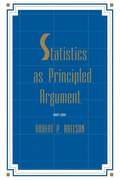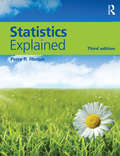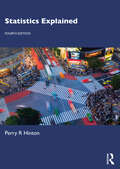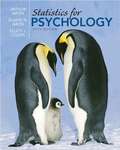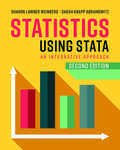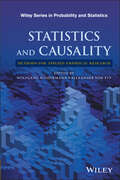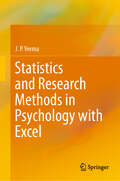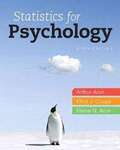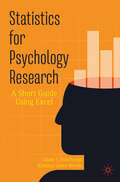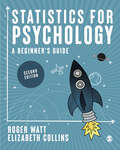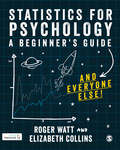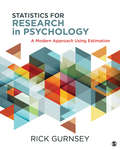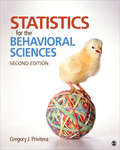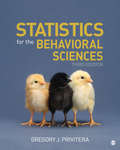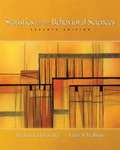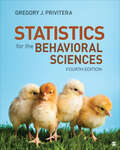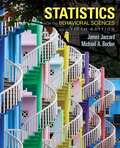- Table View
- List View
Statistics As Principled Argument
by Robert P. AbelsonIn this illuminating volume, Robert P. Abelson delves into the too-often dismissed problems of interpreting quantitative data and then presenting them in the context of a coherent story about one's research. Unlike too many books on statistics, this is a remarkably engaging read, filled with fascinating real-life (and real-research) examples rather than with recipes for analysis. It will be of true interest and lasting value to beginning graduate students and seasoned researchers alike. The focus of the book is that the purpose of statistics is to organize a useful argument from quantitative evidence, using a form of principled rhetoric. Five criteria, described by the acronym MAGIC (magnitude, articulation, generality, interestingness, and credibility) are proposed as crucial features of a persuasive, principled argument. Particular statistical methods are discussed, with minimum use of formulas and heavy data sets. The ideas throughout the book revolve around elementary probability theory, t tests, and simple issues of research design. It is therefore assumed that the reader has already had some access to elementary statistics. Many examples are included to explain the connection of statistics to substantive claims about real phenomena.
Statistics Explained
by Perry R. HintonStatistics Explained is an accessible introduction to statistical concepts and ideas. It makes few assumptions about the reader’s statistical knowledge, carefully explaining each step of the analysis and the logic behind it. The book: provides a clear explanation of statistical analysis and the key statistical tests employed in analysing research data gives accessible explanations of how and why statistical tests are used includes a wide range of practical, easy-to-understand worked examples. Building on the international success of earlier editions, this fully updated revision includes developments in statistical analysis, with new sections explaining concepts such as bootstrapping and structural equation modelling. A new chapter - ‘Samples and Statistical Inference’ - explains how data can be analysed in detail to examine its suitability for certain statistical tests. The friendly and straightforward style of the text makes it accessible to all those new to statistics, as well as more experienced students requiring a concise guide. It is suitable for students and new researchers in disciplines including Psychology, Education, Sociology, Sports Science, Nursing, Communication, and Media and Business Studies. Presented in full colour and with an updated, reader-friendly layout, this new edition also comes with a companion website featuring supplementary resources for students. Unobtrusive cross-referencing makes it the ideal companion to Perry R. Hinton’s SPSS Explained, also published by Routledge. Perry R. Hinton has many years of experience in teaching statistics to students from a wide range of disciplines and his understanding of the problems students face forms the basis of this book.
Statistics Explained
by Perry R. HintonStatistics Explained, now in its fully revised Fourth Edition, is for students and researchers who wish to understand the statistical analyses used to analyse quantitative (numerical) research data in a wide range of academic disciplines, in particular, the behavioural, human and social sciences.This book explains, in a clear and informative manner, the logic of statistical analysis, in particular the null hypothesis significance testing (NHST) method. Using this method, a range of statistical tests have been devised for different types of data. Each of these tests is explained in the book by adopting a step-by-step (“walkthrough”) approach with a specific illustrative example. Crucially, these explanations do not require the reader to have an advanced knowledge of mathematics or statistics, but only assumes the basic mathematics which most readers will have learnt at high school. The book also examines the criticisms of NHST and introduces the reader to Bayesian statistics. As a result the reader will be able to critically evaluate the outcomes of statistical analysis both of their own work and that of others.Statistics Explains will be of great interest to students and researchers in the behavioural, human and social sciences in understanding both the outcomes of their own research and also the research reports in the academic journals.
Statistics For Psychology
by Elaine Aron Arthur Aron Elliot CoupsThis author team is committed to making statistics a highlight for psychology students! Now, in a 5th edition, Statistics for Psychology, continues to be an accessible, current, and interesting approach to statistics. With each revision, the authors have maintain those things about the book that have been especially appreciated, while reworking the text to take into account the feedback, their our own experiences, and advances and changes in the field. The fifth edition of this popular text uses definitional formulas to emphasize concepts of statistics, rather than rote memorization. This approach constantly reminds students of the logic behind what they are learning, and each procedure is taught both verbally and numerically, which helps to emphasize the concepts. Thoroughly revised, with new content and many new practice examples, this text takes the reader from basic procedures through analysis of variance (ANOVA). While learning statistics, students also learn how to read and interpret current research.
Statistics Using Stata: An Integrative Approach
by Sharon Lawner Weinberg Sarah Knapp AbramowitzBuilding upon the success of the first edition, Statistics Using Stata uses the latest version of Stata to meet the needs of today's students. Engaging and accessible for students from a variety of mathematical backgrounds, this textbook integrates statistical concepts with the Stata (version 16) software package. It aligns Stata commands with examples based on real data, enabling students to understand statistics in a way that reflects statistical practice. Capitalizing on Stata's menu-driven 'point and click' and program syntax interface, the chapters guide students from the comfortable 'point and click' environment to the beginnings of statistical programming. Its coverage of essential topics gives instructors flexibility in curriculum planning and provides students with more advanced material to prepare for future work. Online resources - including solutions to exercises, PowerPoint slides, and Stata syntax (do-files) for each chapter - allow students to review independently and adapt code to analyze new problems.
Statistics and Causality: Methods for Applied Empirical Research
by Alexander Von Eye Wolfgang WiedermannA one-of-a-kind guide to identifying and dealing with modern statistical developments in causality Written by a group of well-known experts, Statistics and Causality: Methods for Applied Empirical Research focuses on the most up-to-date developments in statistical methods in respect to causality. Illustrating the properties of statistical methods to theories of causality, the book features a summary of the latest developments in methods for statistical analysis of causality hypotheses. The book is divided into five accessible and independent parts. The first part introduces the foundations of causal structures and discusses issues associated with standard mechanistic and difference-making theories of causality. The second part features novel generalizations of methods designed to make statements concerning the direction of effects. The third part illustrates advances in Granger-causality testing and related issues. The fourth part focuses on counterfactual approaches and propensity score analysis. Finally, the fifth part presents designs for causal inference with an overview of the research designs commonly used in epidemiology. Statistics and Causality: Methods for Applied Empirical Research also includes: * New statistical methodologies and approaches to causal analysis in the context of the continuing development of philosophical theories * End-of-chapter bibliographies that provide references for further discussions and additional research topics * Discussions on the use and applicability of software when appropriate Statistics and Causality: Methods for Applied Empirical Research is an ideal reference for practicing statisticians, applied mathematicians, psychologists, sociologists, logicians, medical professionals, epidemiologists, and educators who want to learn more about new methodologies in causal analysis. The book is also an excellent textbook for graduate-level courses in causality and qualitative logic. Wolfgang Wiedermann, PhD, is Assistant Professor in the Department of Educational, School, and Counseling Psychology at the University of Missouri, Columbia. His research interests include the development of methods for direction dependence analysis and causal inference, the development and evaluation of methods for person-oriented research, and methods for intensive longitudinal data. Alexander von Eye, PhD, is Professor Emeritus of Psychology at Michigan State University. His research interests include statistical methods, categorical data analysis, and human development. Dr. von Eye is Section Editor for the Encyclopedia of Statistics in Behavioral Science and is the coauthor of Log-Linear Modeling: Concepts, Interpretation, and Application, both published by Wiley.
Statistics and Research Methods in Psychology with Excel
by J.P. VermaThis book, specifically developed for students of psychology, covers a wide range of topics in statistics and research designs taught in psychology, in particular, and other disciplines like management, sociology, education, home science, and nutrition, in general, in most universities. It explains how to use Excel to analyze research data by elaborating statistical concepts. Each chapter contains sections like “Check you Computing skill” and “Check your Statistical Concepts” to enable students to assess their knowledge in a graded manner. The book addresses one of the major challenges in psychology research, viz., how to measure subjective phenomenon like attitude, desire, and preferences of an individual. Separate emphasis has been given to the measurement techniques which are essential tools to assess these subjective parameters in numerical form, required for statistical analysis to draw meaningful conclusions. The book is equally helpful to students of humanities, life sciences and other applied areas. Consisting of 14 chapters, the book covers all relevant topics of statistics and research designs which are important for students to plan and complete their research work.
Statistics for People Who (Think They) Hate Statistics: Using Microsoft Excel
by Bruce B. Frey Neil J. SalkindThis Fifth Edition of Neil J. Salkind’s Statistics for People Who (Think They) Hate Statistics: Using Microsoft Excel, presents an often intimidating and difficult subject in a way that is clear, informative, and personable. Opening with an introduction to Excel, including coverage of how to use functions and formulas, this edition shows students how to install the Excel Data Analysis Tools option to access a host of useful analytical techniques. New to the Fifth Edition is new co-author Bruce Frey who has added a new feature on statisticians throughout history (with a focus on the contributions of women and people of color). He has updated the "Real-World Stats" feature, and added more on effect sizes, updated the discussions on hypotheses, measurement concepts like validity and reliability, and has more closely tied analytical choices to the level of measurement of variables.
Statistics for People Who (Think They) Hate Statistics: Using Microsoft Excel
by Bruce B. Frey Neil J. SalkindThis Fifth Edition of Neil J. Salkind’s Statistics for People Who (Think They) Hate Statistics: Using Microsoft Excel, presents an often intimidating and difficult subject in a way that is clear, informative, and personable. Opening with an introduction to Excel, including coverage of how to use functions and formulas, this edition shows students how to install the Excel Data Analysis Tools option to access a host of useful analytical techniques. New to the Fifth Edition is new co-author Bruce Frey who has added a new feature on statisticians throughout history (with a focus on the contributions of women and people of color). He has updated the "Real-World Stats" feature, and added more on effect sizes, updated the discussions on hypotheses, measurement concepts like validity and reliability, and has more closely tied analytical choices to the level of measurement of variables.
Statistics for Psychologists: An Intermediate Course (Arnold Student Reference Ser.)
by Brian S. EverittBuilt around a problem solving theme, this book extends the intermediate and advanced student's expertise to more challenging situations that involve applying statistical methods to real-world problems. Data relevant to these problems are collected and analyzed to provide useful answers. Building on its central problem-solving theme, a large number of data sets arising from real problems are contained in the text and in the exercises provided at the end of each chapter. Answers, or hints to providing answers, are provided in an appendix. Concentrating largely on the established SPSS and the newer S-Plus statistical packages, the author provides a short, end-of-chapter section entitled Computer Hints that helps the student undertake the analyses reported in the chapter using these statistical packages.
Statistics for Psychology (MyStatLab Series)
by Elaine Aron Arthur Aron Elliot CoupsStatistics for Psychology, 6th edition places definitional formulas center stage to emphasize the logic behind statistics and discourage rote memorization. Each procedure is explained in a direct, concise language and both verbally and numerically. <p><p> MyStatLab is an integral part of the Statistics course. MyStatLab gives students practice with hundreds of homework problems. Every problem includes tools to help students understand and solve each problem - and grades all of the problems for instructors. MyStatLab also includes tests, quizzes, eText, a Gradebook, a customizable study plan, and much more.
Statistics for Psychology Research: A Short Guide Using Excel
by Adam T. Hutcheson Kristina Groce BrownThis book aims to help psychology students build their skills to conduct research and analyses using Microsoft Excel’s Data Analysis Toolpak. Concise yet comprehensive, this accessible textbook walks students through basic research methodology, central tendency, variability, standardized scores, t-tests (independent and related samples), One-way Analysis of Variance (between-groups and repeated measures), the Pearson correlation, and Chi Square analyses. Each chapter includes examples of research questions to be addressed, the rationale for the analysis, a step-by-step analysis of the dataset in equation format and using Microsoft Excel, and how to present results in APA (7th Edition) style. The extensive didactic material encompasses end-of-chapter questions, learning outcomes, sidebar boxes with common mistakes to avoid, and biographical sketches of those who developed research methods and statistical techniques. Students and instructors will also benefit from a companion website where PowerPoint slides and additional exercises, datasets, and resources are available. Ideal for undergraduate psychology courses, this textbook can also be of use for those interested in learning more about statistical research and its practical application at university and beyond. Test your knowledge with questions and answers about the book with Springer Nature Flashcards.
Statistics for Psychology: A Beginner′s Guide
by Elizabeth Collins Roger WattStatistics for Psychology is an interactive, highly visual, and accessible guide to the statistical practices you will encounter as a psychology student. Its software-agnostic approach keeps the focus on the core principles, rather than getting bogged down in complicated formulae and jargon. This book is based on the authors′ BPS commended programme. It focusses on providing the strong foundational understanding you’ll need to use statistics confidently and creatively rather than the software-specific way in which statistics is often taught. This edition includes: new content throughout on being a responsible researcher, a new chapter to support you in presenting your research to a critical audience, carefully designed graphics to explain statistical principles, "your turn" exercises to test your understanding of each chapter. This book is the ideal guide for students approaching statistics and research methods in psychology for the first time. Roger Watt is Emeritus Professor of Psychology at the University of Stirling. Elizabeth Collins is a researcher with a PhD in Psychology.
Statistics for Psychology: A Beginner′s Guide
by Elizabeth Collins Roger WattStatistics for Psychology is an interactive, highly visual, and accessible guide to the statistical practices you will encounter as a psychology student. Its software-agnostic approach keeps the focus on the core principles, rather than getting bogged down in complicated formulae and jargon. This book is based on the authors′ BPS commended programme. It focusses on providing the strong foundational understanding you’ll need to use statistics confidently and creatively rather than the software-specific way in which statistics is often taught. This edition includes: new content throughout on being a responsible researcher, a new chapter to support you in presenting your research to a critical audience, carefully designed graphics to explain statistical principles, "your turn" exercises to test your understanding of each chapter. This book is the ideal guide for students approaching statistics and research methods in psychology for the first time. Roger Watt is Emeritus Professor of Psychology at the University of Stirling. Elizabeth Collins is a researcher with a PhD in Psychology.
Statistics for Psychology: A Guide for Beginners (and everyone else)
by Mr. Roger Watt Ms. Elizabeth CollinsThis concise, easy-to-understand and highly visual book helps students to understand the principles behind the many statistical practices. This text helps students to build a mental map to enable them to work their way through tests and procedures with a better level of understanding (and ultimately feel more confident and get better grades). Statistical analysis will also be covered in the book in the same simple-to-follow way, without messy details or complicated formulae. However, this approach does not lead to simple understanding. Instead it allows students to really grasp how to use, and be creative with, statistics. Key features: A principles-based approach, helping students to apply and adapt their skills to a variety of situation Test out principles in practice on the companion website with statistics scenarios Carefully designed graphics to explain statistical principles Links to relevant sources / further reading for statistical packages, so the book can be used as a portal to/ springboard for further study. Developed in conjunction with students means this book answers the key challenges students face. Based on a BPS commended programme Supported by a wealth of online resources at www.sagepub.co.uk/statisticsforpsychology
Statistics for Psychology: A Guide for Beginners (and everyone else)
by Mr. Roger Watt Ms. Elizabeth CollinsThis concise, easy-to-understand and highly visual book helps students to understand the principles behind the many statistical practices. This text helps students to build a mental map to enable them to work their way through tests and procedures with a better level of understanding (and ultimately feel more confident and get better grades). Statistical analysis will also be covered in the book in the same simple-to-follow way, without messy details or complicated formulae. However, this approach does not lead to simple understanding. Instead it allows students to really grasp how to use, and be creative with, statistics. Key features: A principles-based approach, helping students to apply and adapt their skills to a variety of situation Test out principles in practice on the companion website with statistics scenarios Carefully designed graphics to explain statistical principles Links to relevant sources / further reading for statistical packages, so the book can be used as a portal to/ springboard for further study. Developed in conjunction with students means this book answers the key challenges students face. Based on a BPS commended programme Supported by a wealth of online resources at www.sagepub.co.uk/statisticsforpsychology
Statistics for Research in Psychology: A Modern Approach Using Estimation
by Rick GurnseyStatistics for Research in Psychology by Rick Gurnsey offers an intuitive approach to statistics based on estimation for interpreting research in psychology. This innovative text covers topic areas in a traditional sequence but gently shifts the focus to an alternative approach using estimation, emphasizing confidence intervals, effect sizes, and practical significance, with the advantages naturally emerging in the process. Frequent opportunities for practice and step-by-step instructions for using Excel, SPSS, and R in appendices will help readers come away with a better understanding of statistics that will allow them to more effectively evaluate published research and undertake meaningful research of their own.
Statistics for Research in Psychology: A Modern Approach Using Estimation
by Rick GurnseyStatistics for Research in Psychology by Rick Gurnsey offers an intuitive approach to statistics based on estimation for interpreting research in psychology. This innovative text covers topic areas in a traditional sequence but gently shifts the focus to an alternative approach using estimation, emphasizing confidence intervals, effect sizes, and practical significance, with the advantages naturally emerging in the process. Frequent opportunities for practice and step-by-step instructions for using Excel, SPSS, and R in appendices will help readers come away with a better understanding of statistics that will allow them to more effectively evaluate published research and undertake meaningful research of their own.
Statistics for the Behavioral Sciences
by Dr Gregory J. PriviteraStatistics for the Behavioral Sciences, Second Edition, engages students in an ongoing spirit of discovery by illustrating how statistics apply to modern-day research problems. By integrating robust pedagogy as well as screenshots and practical examples for using IBM SPSS® Statistics software, award-winning author Gregory J. Privitera balances statistical theory, computation, and application with the technical instruction needed for students to succeed in the modern era of data collection, analysis, and statistical interpretation. Fully updated with current research and a full-color design, this new edition features even more real-world examples and an updated Student Study Guide with SPSS Workbook. “Privitera does an EXCELLENT job of balancing clarity with depth.” —Ronald W. Stoffey, Kutztown University of Pennsylvania “The writing style and the presentation of material are not only ENJOYABLE TO READ but are EASY TO FOLLOW and understand.” —Joshua J. Dobias, Rutgers University “Privitera ties research methods, SPSS, and statistics together in a SEAMLESS fashion.” —Walter M. Yamada, Azusa Pacific University “I like the objectives, the readability of the text, the straightforwardness of the presentations of concepts, the problems that are quite APPROPRIATE ON MANY LEVELS (computation, theory, etc.), and the emphasis on SPSS.” —Ted R. Bitner, DePauw University
Statistics for the Behavioral Sciences
by Dr Gregory J. PriviteraThe engaging Third Edition of Statistics for the Behavioral Sciences shows students that statistics can be understandable, interesting, and relevant to their daily lives. Using a conversational tone, award-winning teacher and author Gregory J. Privitera speaks to the reader as researcher when covering statistical theory, computation, and application. Robust pedagogy allows students to continually check their comprehension and hone their skills when working through carefully developed problems and exercises that include current research and seamless integration of SPSS. This edition will not only prepare students to be lab-ready, but also give them the confidence to use statistics to summarize data and make decisions about behavior.
Statistics for the Behavioral Sciences
by Dr Gregory J. PriviteraThe engaging Third Edition of Statistics for the Behavioral Sciences shows students that statistics can be understandable, interesting, and relevant to their daily lives. Using a conversational tone, award-winning teacher and author Gregory J. Privitera speaks to the reader as researcher when covering statistical theory, computation, and application. Robust pedagogy allows students to continually check their comprehension and hone their skills when working through carefully developed problems and exercises that include current research and seamless integration of SPSS. This edition will not only prepare students to be lab-ready, but also give them the confidence to use statistics to summarize data and make decisions about behavior.
Statistics for the Behavioral Sciences
by Frederick J. Gravetter Larry B. WallnauMaster statistics with STATISTICS FOR THE BEHAVIORAL SCIENCES! With straightforward instruction, built-in learning aids, and real world examples, this psychology text provides you with the tools you need to succeed. You will have numerous opportunities to practice statistical techniques through learning checks, examples, demonstrations, and problems. Exam preparation is made easy with a student companion website that provides tutorials, crossword puzzles, flashcards, learning objectives, and more!
Statistics for the Behavioral Sciences
by Gregory J. PriviteraRecipient of the 2024 Textbook & Academic Authors Association (TAA) Textbook Excellence Award This award recognizes excellence in current textbooks and learning materials. Statistics for the Behavioral Sciences by award-winning author Gregory Privitera aims to not only inspire students to use statistics properly to better understand the world around them, but also to develop the skills to be lab-ready in applied research settings. Incorporating examples from current, relatable research throughout the text, Privitera shows students that statistics can be relevant, interesting, and accessible. Robust pedagogy encourages students to continually check their comprehension and hone their skills by working through problem sets throughout the text, including exercises that seamlessly integrate SPSS. This new Fourth Edition gives students a greater awareness of the best practices of analysis in the behavioral sciences, with a focus on transparency in recording, managing, analyzing, and interpreting data. Included with this title: LMS Cartridge: Import this title′s instructor resources into your school′s learning management system (LMS) and save time. Don′t use an LMS? You can still access all of the same online resources for this title via the password-protected Instructor Resource Site.
Statistics for the Behavioral Sciences
by Gregory J. PriviteraRecipient of the 2024 Textbook & Academic Authors Association (TAA) Textbook Excellence Award This award recognizes excellence in current textbooks and learning materials. Statistics for the Behavioral Sciences by award-winning author Gregory Privitera aims to not only inspire students to use statistics properly to better understand the world around them, but also to develop the skills to be lab-ready in applied research settings. Incorporating examples from current, relatable research throughout the text, Privitera shows students that statistics can be relevant, interesting, and accessible. Robust pedagogy encourages students to continually check their comprehension and hone their skills by working through problem sets throughout the text, including exercises that seamlessly integrate SPSS. This new Fourth Edition gives students a greater awareness of the best practices of analysis in the behavioral sciences, with a focus on transparency in recording, managing, analyzing, and interpreting data. Included with this title: LMS Cartridge: Import this title′s instructor resources into your school′s learning management system (LMS) and save time. Don′t use an LMS? You can still access all of the same online resources for this title via the password-protected Instructor Resource Site.
Statistics for the Behavioral Sciences
by James Jaccard Michael A. BeckerNow you can become an intelligent consumer of scientific research, without being overwhelmed by the statistics! Jaccard and Becker's book teaches readers the basic skills for analyzing data and helps them become intelligent consumers of scientific information. Praised for its real-life applications, the book tells readers when to use a particular statistic, why they should use it, and how the statistic should be computed and interpreted. Because many readers, given a set of data, cannot determine where to begin in answering relevant research questions, the authors explicate the issues involved in selecting a statistical test. Each statistical technique is introduced by giving instances where the test is most typically applied followed by an interesting research example (each example is taken from psychology literature).
